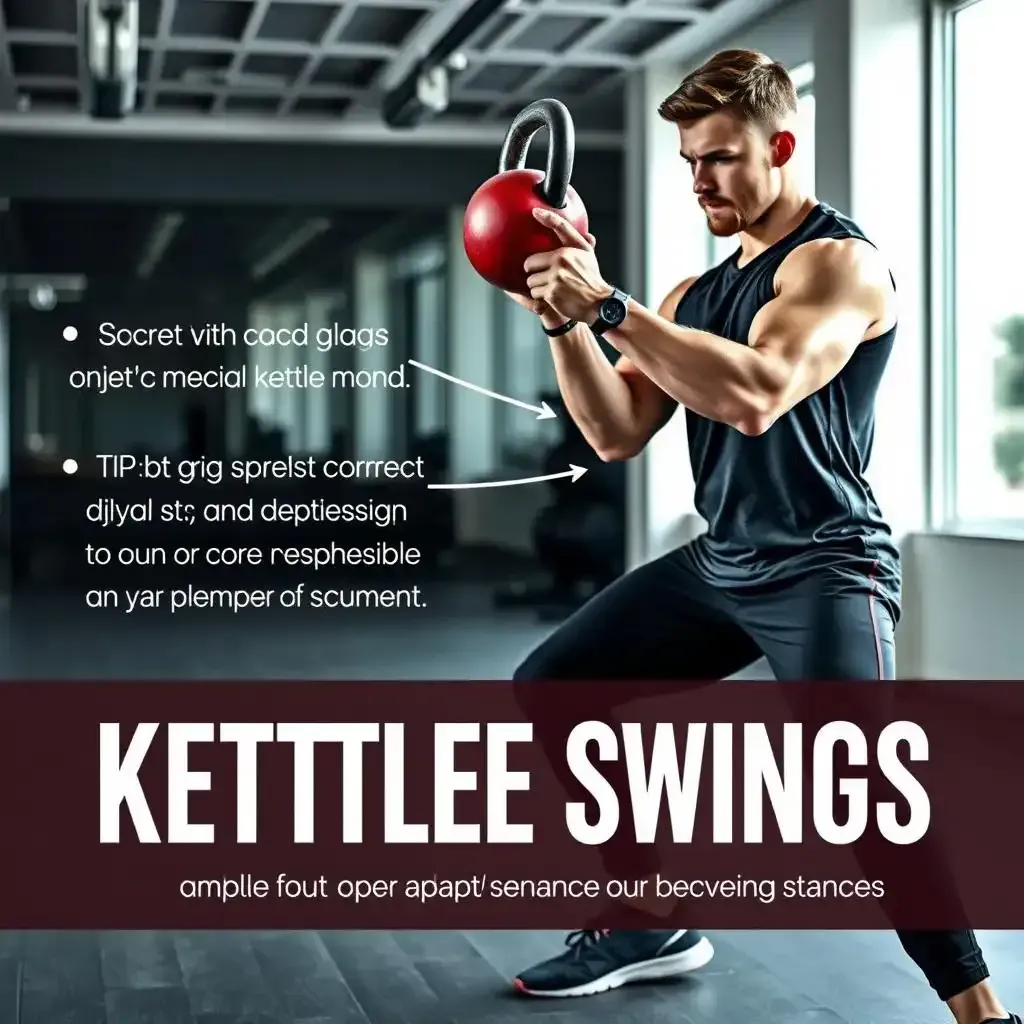Table of Contents
So, you're thinking about trying kettlebell workouts for beginners? That's awesome! Kettlebells are amazing tools for building strength, improving your cardiovascular health, and even boosting your coordination. But let's be honest, stepping into a new workout routine can feel a little intimidating. Where do you even start? What exercises are safe for beginners? This guide is your friendly, no-nonsense walkthrough to getting started with kettlebells. We'll cover everything from choosing the right kettlebell weight to building a full-body routine that's both challenging and enjoyable. Forget complicated jargon and confusing instructions; we're keeping things simple, clear, and fun. Ready to let loose your inner fitness beast? Let's get started! Remember, you can always find more helpful information and resources at kettlebellworkout.homes.
Kettlebell Workouts for Beginners: Getting Started Safely

Kettlebell Workouts For Beginners Getting Started Safely
Hey there, fellow fitness explorer! So you're diving into the world of kettlebells? Fantastic choice! But let's be real, starting anything new can feel a bit like trying to steer a maze blindfolded. That's why safety is my number one priority when it comes to kettlebell workouts for beginners. Imagine kettlebells as playful puppies – powerful, but needing a little guidance. You wouldn't just throw a puppy a stick and expect it to fetch perfectly, right? Same goes for kettlebells.
First things first: find a good, clear space. You need enough room to swing that kettlebell without knocking over your grandma's prize-winning begonias (or worse, yourself!). Next, choosing the right weight is crucial. We're not aiming for a world record here; we're aiming for proper form. Start with a lighter kettlebell – think of it as a warm-up round before the main event. You should be able to control the weight easily. If you're struggling, it’s too heavy! Check out our kettlebell weight guide for more info.
Step | Action | Tip |
|---|---|---|
1 | Choose your space | Clear, ample room is essential. |
2 | Select your weight | Start light, focus on form. |
3 | Warm-up | Prepare your muscles to prevent injury. |
Think of your warm-up as tuning up your car before a long drive; it prevents breakdowns! A quick five-minute warm-up of dynamic stretches – arm circles, leg swings, torso twists – will get your blood flowing and your muscles ready to rumble. And trust me, ignoring this step is a recipe for disaster. You want to feel energized, not like a rusty robot trying to lift a car. After your warm-up, remember to cool down too! This helps your body recover. Find more tips for staying injury-free in our injury prevention guide.
Finally, and this is huge: proper form. Seriously, YouTube is your friend here. Watch videos, read articles, maybe even consider a few sessions with a trainer. Good form is the difference between a killer workout and a trip to the physio. Think of it like learning to ride a bike; you won't master it overnight, but with practice and the right guidance, you'll be cruising in no time. Remember, we're here to help you build a strong foundation. You might find our kettlebell form guide especially helpful.
- Find a safe space
- Choose the right weight
- Warm-up before you start
- Focus on proper form
“The best way to predict the future is to create it.” – Abraham Lincoln. This applies to your fitness process too! Start small, build gradually and you'll see amazing results. Don't be afraid to ask for help; there are tons of resources available to support you. Let's make this a successful and injury-free start! Remember, safety is key when it comes to kettlebell workouts for beginners. We've got plenty more tips to help you on your way. Check out our kettlebell training for starters page for more advice!
Beginner Kettlebell Exercises: Mastering the Fundamentals

Beginner Kettlebell Exercises Mastering The Fundamentals
Start with the Basics
Alright, let's investigate into the fun stuff! The first step in mastering kettlebell workouts for beginners is to get comfortable with the basics. Think of it like learning to ride a bike. You start with the training wheels, right? These exercises are your training wheels. They'll build your confidence and set the foundation for more advanced moves.
First up, let's talk about the grip. Your grip is like the steering wheel of your kettlebell progression. A strong, secure grip means you can control the kettlebell, which is crucial for safety and effectiveness. Start by holding the kettlebell with both hands and getting a feel for its weight. Then, practice your grip by alternating hands. This will help you develop the strength and stability you need for more complex exercises.
Exercise | Description | Tip |
|---|---|---|
Grip Practice | Holding the kettlebell with both hands, alternating hands. | Focus on a firm, yet relaxed grip. |
Try the Kettlebell Swings
Now that you've got a solid grip, let's move on to the kettlebell swing. This is one of the most fundamental kettlebell exercises, and it's a powerhouse move for building strength and endurance. Imagine you're a pendulum; the kettlebell is the weight, and your hips are the pivot point. The key is to use your hips to generate the force, not your arms.
To perform a kettlebell swing, start with your feet shoulder-width apart. Bend your knees slightly and hinge at the hips, keeping your back straight. Grab the kettlebell with both hands, and then explosively thrust your hips forward, swinging the kettlebell up to about shoulder height. As you swing, keep your core engaged and your glutes tight. Control the kettlebell on the way down and repeat.
- Feet shoulder-width apart
- Slightly bent knees
- Hinge at the hips, back straight
- Grab the kettlebell with both hands
- Explosively thrust hips forward
- Swing the kettlebell to shoulder height
- Control the kettlebell on the way down
Remember, the kettlebell swing is all about form. You can check out our technique tips for more detailed guidance. Practice the movement slowly at first to get the hang of it. Once you feel confident, you can increase the speed and intensity.
Kettlebell Workouts for Beginners: Building a Full-Body Routine
Now that you've got the basics down, it's time to build a full-body routine using kettlebells. Think of this as putting all the puzzle pieces together to create a complete imagine. A full-body kettlebell workout should target all major muscle groups, ensuring a balanced and effective routine. Just like a well-cooked meal, you need a mix of different ingredients to make it work.
Start by incorporating a variety of movements. Squatting, hip-hinging, pressing, rowing, and rotational movements are your go-to exercises. Each one targets different areas, helping you build strength and endurance from head to toe. For example, the kettlebell squat engages your legs and glutes, while the kettlebell row targets your back and biceps. Mixing these exercises ensures you get a well-rounded workout that leaves no muscle group untouched.
- Squatting
- Hip-hinging
- Pressing
- Rowing
- Rotational movements
Let's examine into a sample 20-minute beginner kettlebell workout. This circuit is perfect for getting started and can be repeated three times for a full session. Each exercise is simple, effective, and designed to challenge you without overwhelming you. Check out our workout tips for more guidance on how to structure your routine.
1. Kettlebell Swing - 30 seconds: Stand with your feet shoulder-width apart, hinge at the hips, and thrust your hips forward to swing the kettlebell to shoulder height. Control it on the way down and repeat.
2. Kettlebell Goblet Squat - 30 seconds: Hold the kettlebell close to your chest, stand with your feet shoulder-width apart, and squat down as low as you can. Push through your heels to stand back up.
3. Kettlebell Deadlift - 30 seconds: Stand with your feet shoulder-width apart, place the kettlebell on the ground in front of you, and hinge at the hips to lift the kettlebell. Keep your back straight and engage your core.
4. Kettlebell Overhead Press - 30 seconds: Hold the kettlebell at shoulder height, press it overhead until your arm is fully extended, and then lower it back down. Keep your core tight and your movements controlled.
5. Kettlebell Russian Twist - 30 seconds: Sit on the floor with your knees bent and feet flat. Hold the kettlebell with both hands, lean back slightly, and twist your torso to the left and right, tapping the kettlebell on the ground each side.
Exercise | Duration | Description |
|---|---|---|
Kettlebell Swing | 30 seconds | Thrust hips forward to swing the kettlebell up. |
Goblet Squat | 30 seconds | Hold kettlebell at chest, squat down, and stand up. |
Deadlift | 30 seconds | Hinge at hips to lift kettlebell from the ground. |
Overhead Press | 30 seconds | Press kettlebell overhead and lower it back down. |
Russian Twist | 30 seconds | Twist torso and tap kettlebell on the ground. |
Remember, the key to a successful full-body kettlebell workout is consistency and proper form. Don't rush through the exercises; focus on each movement and make sure you're doing them correctly. If you need a visual guide, check out our for step-by-step instructions and video demonstrations.
Advanced Kettlebell Workouts for Beginners: Progressing Your Training

Advanced Kettlebell Workouts For Beginners Progressing Your Training
Okay, so you've mastered the basics – congrats! You're swinging like a pro (or at least, you're *trying* to swing like a pro, which is half the battle!). Now it's time to kick things up a notch. Think of it like leveling up in a video game – you've conquered the first few levels, but there are tougher challenges ahead! This is where you start to really see the amazing benefits of kettlebell training. It's not just about getting stronger; it's about building endurance, coordination and that satisfying feeling of accomplishment. And don't worry, I'm not going to throw you into the deep end here. We'll build up gradually – one step at a time.
One way to progress is by increasing the weight of your kettlebell. But don't go crazy! Remember, it's better to use a lighter weight and maintain proper form than to struggle with a heavy kettlebell and risk injury. Think of it like learning to ride a bike – you wouldn't immediately try to ride a mountain bike down a steep hill, would you? You start with a smaller, lighter bike on a flat surface. Start by increasing the weight by a small amount, maybe 2-5 pounds, and see how that feels. If you're comfortable, you can gradually increase the weight over time. You can find a helpful guide to choosing the right weight on our page.
- Gradually increase weight
- Focus on proper form
- Listen to your body
Another way to challenge yourself is by increasing the number of repetitions or sets you do. Start slowly and gradually increase the reps and sets as you feel more comfortable. Don't push yourself too hard, too fast. You can find some great workout tips to help you find the perfect balance between challenging yourself and avoiding injury on our page. Remember that consistency is key – even small improvements add up over time.
You can also add more advanced exercises to your routine. Once you're feeling confident with the basic swings, squats, and rows, you can try more challenging movements, such as Turkish get-ups, cleans, and snatches. But remember, these are more advanced moves and require proper technique. It's always a good idea to watch videos or work with a trainer to learn the proper form before attempting these exercises. Start slow, focus on form, and don't be afraid to ask for help! Check out our page for some extra tips and resources.
Exercise | Description | Tip |
|---|---|---|
Turkish Get-Up | A full-body exercise that involves getting up from the ground while holding a kettlebell. | Focus on maintaining a stable core. |
Clean | A powerful movement that involves lifting the kettlebell from the ground to the shoulder. | Use your hips and legs to generate strength. |
Snatch | A dynamic movement that involves lifting the kettlebell from the ground to overhead in one fluid motion. | Focus on maintaining a straight line from your feet to your head. |
"The only way to do great work is to love what you do." - Steve Jobs. And I love kettlebells! Remember, there's no rush. Listen to your body, and don't be afraid to take rest days when needed. The key is to enjoy the process and celebrate your progress along the way. You might find some advanced routines on our advanced kettlebell routines page.
Finally, remember to have fun! Kettlebell training should be an enjoyable experience. Find exercises that you enjoy and that challenge you. Don't be afraid to experiment and find what works best for your body and your fitness goals. And don't forget to share your progress with others – maybe even inspire someone else to start their own kettlebell process! You've got this!
Final Thought
Starting a new fitness process with kettlebells can be incredibly rewarding. Remember to prioritize proper form, listen to your body, and celebrate your progress along the way. With consistent effort and the right approach, you'll be amazed at the strength and fitness you can achieve. Keep exploring different kettlebell workouts for beginners, and don't hesitate to seek guidance from experienced trainers or online resources. Happy lifting!